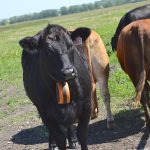Feeder cattle in demand | “If you’re in cow-calf, this is what you live for,” says economist
The future of the Canadian cattle feeding industry is bright, but it is brightest of all for cow-calf producers, says a U.S. economist.
Bruce Ginn, a partner in BMI Ag Services in Kansas, recently told cattle feeders that they face short-term challenges but a positive future because of low cattle numbers driving demand.
Low supplies are raising the cost of replacement animals, and risk management will be vital.
“I think the long-term future for the industry is positive, but that’s with the caveat that you’ve got to get over these challenges,” he said.
Read Also

Why feds imposed EV tariffs
Moe and Kinew have a fight on their hands when it comes to eliminating the EV tariff. Canada has to worry about pissing off the U.S. and Mexico and hundreds of thousands of auto workers.
Ranchers, on the other hand, are looking at two or three years of high times.
“The most profitable segment of the industry, given the supply-demand situation, is absolutely the rancher, and that’s not going to change for a couple years,” Ginn said in a later interview.
“If you’re in cow-calf, this is what you live for.”
Cattle numbers in the United States are at their lowest point in 40 years, he said. Canadian numbers are also low. With feeders looking to fill their yards, demand for cattle will be fierce in both countries.
“The United States is going to represent that giant sucking sound for feeder cattle demand, just because prices are going to be high and there’s going to be a lot of operations in the States that are going to be willing to pay a lot of money for feeder cattle from this country,” said Ginn.
Drought in the southern U.S. has depleted the herd. It has been particularly severe in Texas, which has 12 percent of the country’s cattle. Ginn expects as many as one million fewer cattle in the next inventory report.
Beef demand is firm, but the real growth last year was in exports. Domestic demand exceeded production, but imports from Canada and Mexico backfilled supply.
U.S. beef exports returned to 2003 levels, and Ginn projects exports of more than three billion pounds in 2012. That could rise substantially if Japan relaxes its rules to accept beef from animals younger than 30 months.
Ginn said only 15 percent of available U.S. beef fits Japan’s younger than 20 months requirement, but 30 to 35 percent is younger than 30 months.
“Since they need the product, guess what, they’re willing to consider changing the rule, which has no basis in science at all.”
It all adds up to a positive outlook, but feeder and packer margins will be tight until supply increases, he said.
Canada’s exports of feeder and fed cattle were low this year. Resolution of the country-of-origin labelling issue could affect that, but the U.S. hasn’t yet indicated whether it plans to appeal a World Trade Organization ruling against COOL.
Ginn said branded beef companies never supported COOL, and he hopes it will be rescinded.
“What it’s done is increase our cost substantially,” he said.
“It’s increased the complexity of our message to our consumer and basically we got no benefits from it. What should happen is they should not appeal the WTO ruling.
“The government should negotiate a way to transition to a less onerous, less impactful deal on the food chain. That would be the best case for the industry.”















